How to Transition from a Low Carb Diet Without Gaining Weight
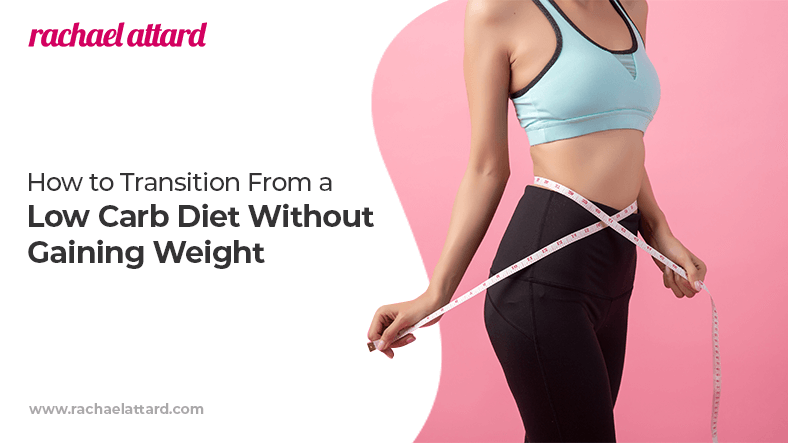
A lot of women I know have tried going on low carb diets in recent years. For some women, these diets are great and sustainable in the long run.
But some of you have asked me how to best switch to eating more carbohydrates without the weight gain or other negative side effects that can come from that transition. :)
What Is a Low Carb Diet?
In general, these diets focus on eating more protein and fat than carbs, especially in comparison to a person’s usual diet.
People who follow low carb diets typically eat more meats, fish, eggs, nuts, seeds, and they might avoid eating bread, grains, some fruit and vegetables, and sugary sweets.
People who go on low carb diets typically do so to lose weight. But low carb diets can have other benefits too.
If you have high blood pressure, high blood sugar, or type 2 diabetes, your doctor might recommend you look into a low-carb diet. These diets can also help reduce bad (LDL) cholesterol and increase good (HDL) cholesterol.
If people want to go on a low carb diet, I typically recommend that they make sure to continue to eat 25-30 percent of their calories as carbohydrates.
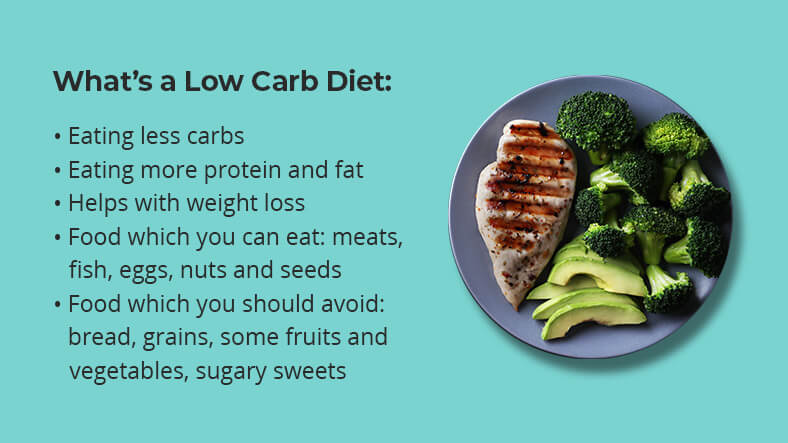
How Low Carb Diets Help With Weight Loss
Studies show that low carb diets work faster in the short term to help with weight loss than other types of diets. But, over the long run, low carb diets don’t typically help people lose more weight than other diets do.
Low carb diets can help with fat loss though. When you eat carbohydrates, your body converts the carbs into glucose. This glucose is necessary for your body and brain to function correctly.
But, if you deprive your body of carbs, your body responds by converting fat into glucose instead. Your body uses more energy from fat than from carbs, which helps you lose fat over the long run.
Types of Low Carb Diets
Low carb diets have been popular on and off for decades. There are lots of different types of low carb diets, and some are more popular than others. Here are some of the most popular:
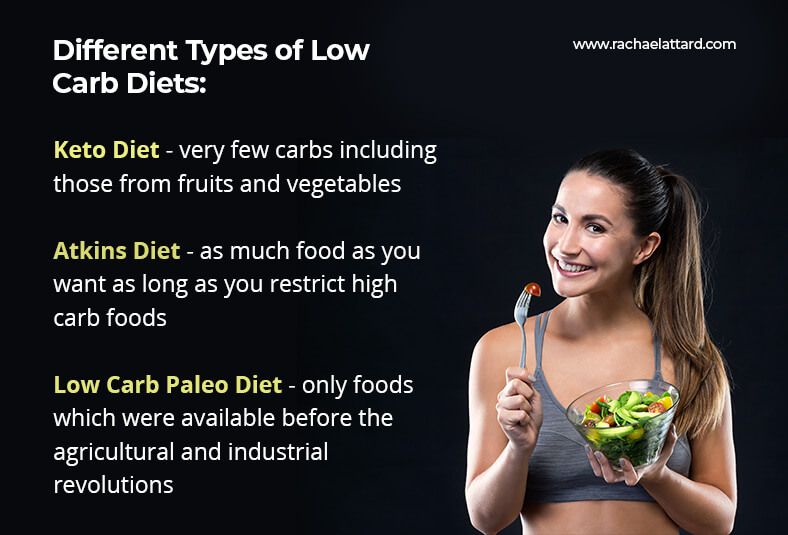
Keto Diet
With the keto diet, you eat very few carbs, including carbs from fruits and vegetables. People who follow this diet eat less than 50 grams of carbs per day, and many will stick to only 20-30 grams of carbs every day.
The goal of this diet is to force your body into a metabolic state called ketosis.
Ketosis occurs when you eat so few carbs, that your insulin level drops, and your body can’t produce enough glucose from its carbohydrate sources.
Your body releases fatty acids from its fat stores, and the liver converts these fatty acids into energy for your brain.
You can learn more about how the keto diet works here.
RELATED POST: Keto Diet and Intermittent Fasting – Should You Combine Them
Atkins Diet
With this diet, you can eat as much food as you want as long as you restrict high carb foods. Because of this, people tend to eat a lot of protein and fat. In theory, they eat meals that more satisfying, and they end up eating less overall because of this.
The diet is fit into four different phases.
- Induction: Eat less than 20 grams of carbs per day for 2 weeks.
- Balancing: Slowly add more fruit, vegetables, and nuts back into your diet.
- Fine-tuning: As you get closer to your weight loss goal, slowly add more carbs back into your diet. Do this until your weight loss becomes slower.
- Maintenance: Eat as many healthy carbs as possible without gaining more weight. Maintain this phase.
Low Carb Paleo Diet
The Paleo diet is a popular diet in which people only eat foods that were available prior to the agricultural and industrial revolutions.
In other words, this means that people can eat:
- Meat and fish
- Eggs
- Fruits and veggies
- Nuts and seeds
- Herbs
- Oils
People on the Paleo diet avoid food like:
- Processed foods
- Sugar
- Dairy
- Grains
- Legumes
- Vegetable oils
People on the Paleo diet don’t have to restrict carbs. But, as you can see, if you follow this diet, you probably are focusing on eating more fat and protein than carbohydrates.
There’s a good chance that somebody on the Paleo diet is eating low carb in practice, even if it isn’t intentional.
RELATED POST: Is the Paleo Diet Good for Weight Loss
Why You Might Want to Transition From a Low Carb Diet

Low carb diets can help people lose weight, lose fat, and reach other health goals. But, for other people, these diets can be holding them back from feeling their best.
There are several reasons why you might find that a low carb diet isn’t working for you. Here are a few:
You Aren’t Eating Enough Fiber
Complex carbohydrates are full of fiber. Your body needs fiber to feel full. Protein and fat can help satisfy you too, but they typically don’t do this as well as fiber does.
Not eating enough fiber can also affect your gastrointestinal system and your bowel movements.
RELATED POST: How to Reduce Your Appetite (If It’s Greater than Normal)
Too Much Protein And Fat
If you reduce your carbohydrate intake, you will most likely increase your fat and protein intake.
Protein contains nitrogen. One of the jobs of your kidneys is to filter nitrogen out of your body. If you eat too much protein, you can put your kidneys under stress and ultimately damage them.
Too much protein can also lead to kidney stones and heart problems.
Eating healthy types of fat (from things like nuts) is good for your body overall. But fat is very high in calories. Eating too much fat might prevent you from losing weight.
You Want to Better Manage Your Hormones
Eating complex carbohydrates, like whole grains, helps your body manage its hormone levels. This is really important for everybody, but especially for women.
Not eating enough carbohydrates can stop your body from producing a thyroid hormone called T3. T3 helps manage your metabolism. Having lower levels of T3 can make you feel tired, sluggish, and cold. It may even prevent you from losing weight.
Studies have also shown that people who don’t eat enough carbohydrates, especially after working out, have higher levels of cortisol and lower levels of testosterone.
In women, low levels of carbohydrates can cause your body to not produce enough estrogen, progesterone, and testosterone. Not having enough of these hormones can affect your mood, libido, immune system, digestive system, and period. Not fun!
RELATED POST: How a Hormone Imbalance Can Cause Weight Gain
You Just Don’t Like It
Low carb diets aren’t for everybody. Maybe you miss the option to enjoy a delicious loaf of bread. Maybe you find that ordering at restaurants or eating with friends has become too cumbersome. Maybe you don’t like meat enough to sustain the diet.
Whatever your reasons, you might find that a low carb diet just won’t be sustainable for you in the long run. That’s ok! Just make sure to transition carefully. :)
What Can Happen If You Don’t Transition Properly
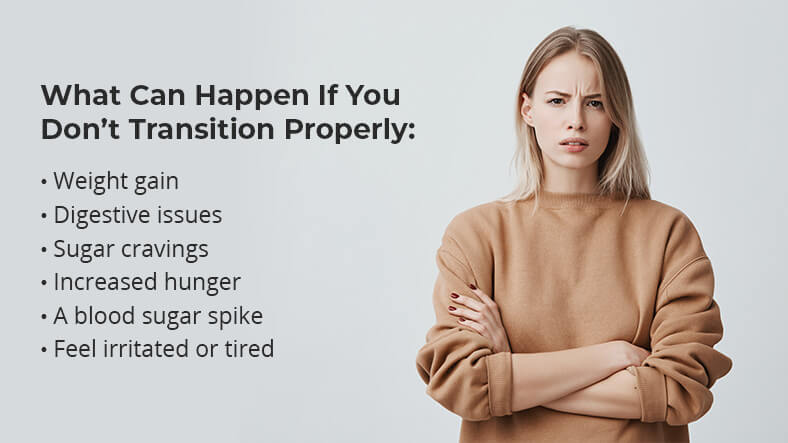
Adjusting to a low carb diet can make you feel tired and slow. It takes time. Similarly, going back to eating more carbs can take a toll on your wellbeing.
If you don’t transition properly you might:
- Gain weight
- Have digestive issues, like bloating
- Start to crave sugar
- Feel hungrier than normal
- Experience a blood sugar spike
- Feel irritable or tired
Tips on How to Transition
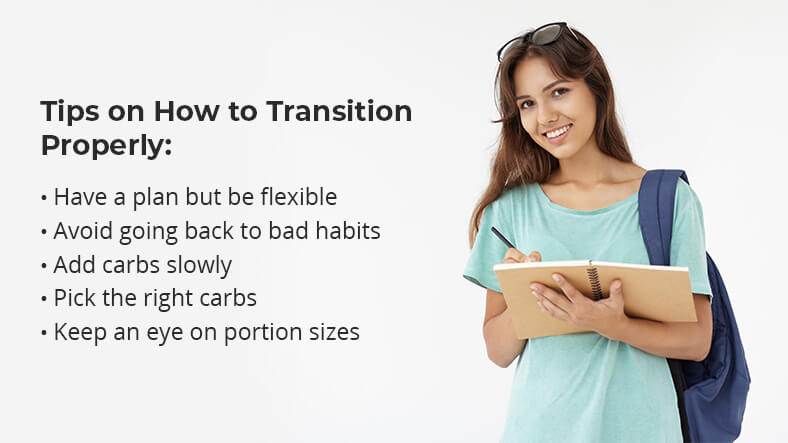
In order to avoid some of the nasty side effects I listed above, it is best to transition slowly and carefully. If you have concerns, make sure to talk to a medical professional. :)
Here are some of my top tips when you decide to transition:
Have a Plan But Be Flexible
Before you start your transition, think through how you are going to transition off of carbs. What meals will you eat? When will you eat them? When will you introduce a certain amount of one type of carbs?
Consider writing down your plan so that you can refer to it in the future. You might also want to write down meals or recipes that you want to try on your calendar.
As you transition, you might find that your plan isn’t working for you. It’s OK to make adjustments as necessary. :)
Avoid Going Back to Bad Habits
When people transition back to high carb diets, they tend to go back to eating the carbs they ate before their diet. This will only cause weight gain and other health problems.
Instead of going back to soda, sugary cereals, white bread, and lots of pasta, try to focus on quality whole-grain food, legumes, and fruits and vegetables. You’ll feel and look much better. :)
Add Carbs Slowly
Adding carbs slowly is important if you want to avoid or lessen gastrointestinal issues.
If you have been following a low carb diet, you probably have been counting your macronutrients. Use that skill and add just 10 grams of carbs back to your diet the first week. Then, adjust as necessary. :)
I suggest writing down how you feel each day too. This will help you track your progress, and you’ll be able to scale back if you notice negative side effects. Take your time!
Start With Unprocessed Carbs
As you’re transitioning, pick fruits and vegetables before going to other types of carbs, especially ones that are highly processed.
Fruits and vegetables have antioxidants, phytonutrients, and fiber that are especially important for your body.
Pick the Right Carbs
I already mentioned that you should focus on fruits and vegetables, whole grains, and legumes. Here are some specific choices that I recommend you include in your diet:
Carrots: These are full of vitamin A, they are great for dipping, and one serving (10 baby carrots) contains 12 grams of carbs!
Edamame: Edamame is one of the yummiest snacks ever. It is also good for you. One 2/3 cup of shelled edamame contains 11 grams of carbs. Edamame is full of fiber, iron, and vitamins too. Some research has shown that plant estrogens in edamame can possibly affect natural estrogen levels in our bodies so if you have any hormone issues, it would be good to talk to your doctor first.
Lentils: If you have been missing fiber in your diet, try eating some lentils. 1/4 cup of lentils is just 57 calories, but it contains 4 g of protein, 10 g of carbs, and 4 g of fiber. If you haven’t had lentils in a long time, start slow so that your stomach can adjust to them.
Oatmeal: Oatmeal is another good source of both fiber and carbohydrates. Top it with some berries and serve with some nuts for fat and protein, and you have a healthy and filling breakfast.
Kiwis, strawberries, and watermelon: All three of these fruits are hydrating, full of vitamins, and have a good amount of carbs. If you notice that you’re craving sugar during your transition, try reaching for one of these fruits instead of candy.
Keep an Eye On Portion Sizes
Being on a low carb diet means that you have probably increased your portions of protein and fat. As you eat more and more carbs, remember to reduce your portion sizes for the rest of your meal.
This will help keep you from gaining weight during the transition period. :)
Transition Properly
Transitioning to a new diet can be a stressful, slow process. But it doesn’t need to make you feel miserable all the time, experience major stomach problems, or gain a significant amount of weight.
By transitioning back to eating more carbs slowly and thoughtfully, you should be able to have a good experience. :) As with any medical topic, be sure to talk to your doctor if you have any health worries!
Let me know if you have any more questions or tips to share in the comments. :)
Love Rachael xx
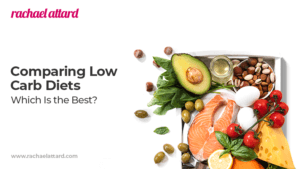

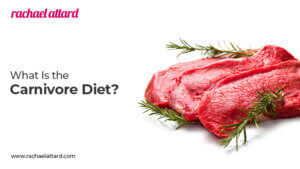
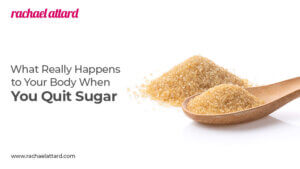

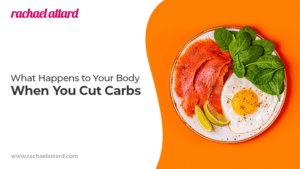

Like seriously,this is what I’m looking for! Rachael,this really enlightened me about carbs. In my country,carbs is almost everywhere and almost inevitable. I tried adjusting them and I made a little mistake and I loss more weight than fat,i’m trying to get back to looking more healthier(mesomorph, a little advice pls??)I’m following Rachael’s free ebooks workout(day 1 to day 3) I can’t go for walk/ run outdoor for some temporary reason so I incorporate running indoors without treadmill(haha I just wanna get enough cardio) I still don’t know if that’s rubbish. I want lean legs but my strength back,fat gone too. Thanks
Hi lovely,
Following the right type of diet and workouts for your body type will definitely help you achieve your goals. Feel free to give this blog post a read. It contains some general guidelines for mesomorphs like you. :)
We don’t really recommend walking/running at home since it just isn’t as effective as doing it outside or on a treadmill.
If you can’t get out for some reason, you can temporarily substitute it for these two in-door cardio videos:
FREE AT-HOME CARDIO VIDEO
FREE AT-HOME CARDIO VIDEO (BOXING)
Again, keep in mind that it’s not as effective as walking is but it will be way better to practice these than skip your daily cardio routine. <3
Love,
Len